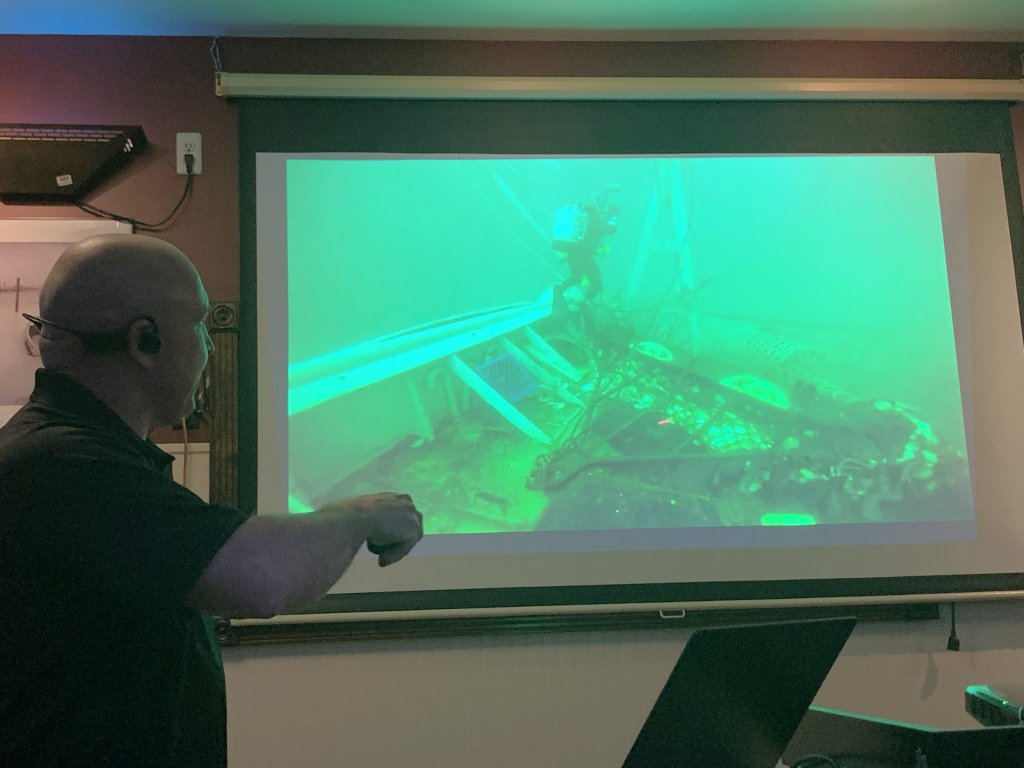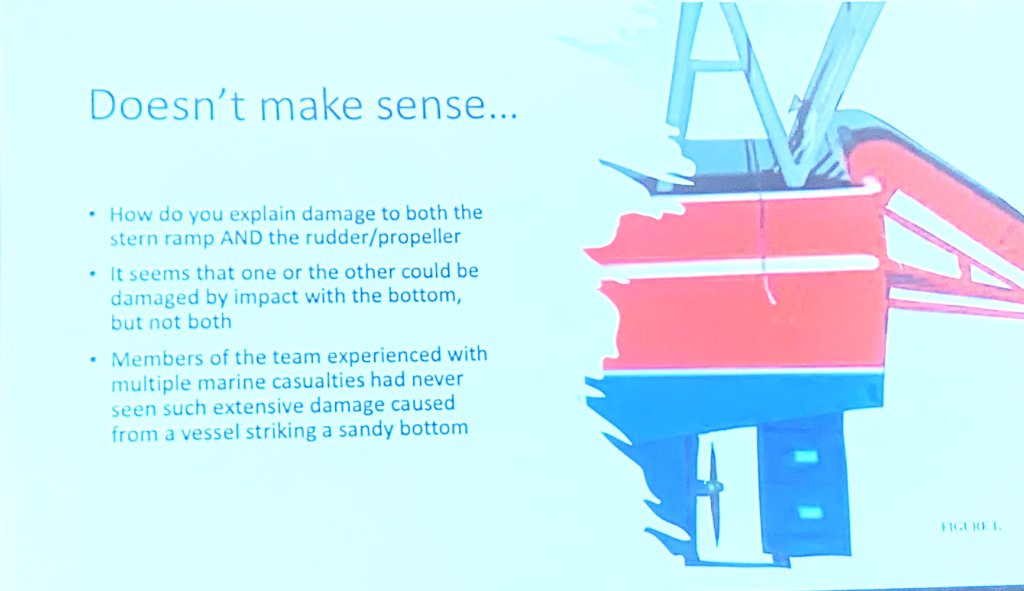CAPE MAY – On March 18, 2009, the F/V Lady Mary, a 71-foot scallop boat, left Cape May Harbor for the scalloping grounds in an area known as the Elephant’s Trunk, roughly 60 miles from Cape May. The crew had nearly completed its catch when, between 5:19 and 5:39 a.m. on March 24, the boat sank. Six of the seven crew members were lost.
Over the next four years, the Coast Guard and the National Transportation Safety Board completed investigations into the sinking, concluding there were multiple factors responsible.
The Coast Guard filed its report on Aug. 23, 2013, saying the Lady Mary did not capsize, nor did it sink due to a fire or explosion. Despite the reported nearby presence of a container vessel named the Cap Beatrice, the Coast Guard concluded there was no evidence that any other vessel was at fault for the chain of events that eventually led to the sinking.
The Coast Guard said that damage to the ship’s rudder, propeller and stern ramp, with the exception of the port stern ramp stay, occurred when the vessel struck the ocean floor. The Coast Guard listed a number of preconditions that existed leading to the sinking, but the ultimate cause is not a settled matter in the minds of everyone involved in the investigation.
Paul Whittaker, a retired New Jersey state trooper and a sports diver, helped provide video and still photography of the wreck of the Lady Mary to the Coast Guard to help it come to its final determination. Whittaker gave a presentation on April 12 at a meeting of the New Jersey Maritime Museum at the Buckalew’s Restaurant and Tavern in Beach Haven.

Whittaker said the Coast Guard was initially hesitant to allow a team of sport divers to visit the site of the sinking and get photographic documentation of the wreck. However, the Coast Guard relented, and on May 12, 2009, roughly seven weeks after the sinking, the team visited the Lady Mary, sitting on the ocean floor 210 feet below the surface.
“The boat looked like it could be sitting on the surface,” Whittaker said.
The fishing vessel was sitting upright on its keel, and the only visible damage was to the stern of the boat; to the rudder, which was dislodged from the boat, and the propeller, whose 2.5-inch stainless steel shaft was bent 30 degrees; and to the dredge ramp, which was driven through the hull of the boat. The dredge, which the boat pulls on the ocean floor to dig up scallops, was sitting on the deck, indicating that the boat and crew were not engaged in fishing when the vessel sank.
The Coast Guard’s description of events in its 278-page report suggests that the Lady Mary completed its final drag and haul-back of the scallop dredge somewhere between midnight and 1:03 a.m., and then drifted until about 5:10 a.m.
Between around 1:17 and 5 a.m., seawater was entering the open hatch area of the lazarette – a storage area beneath the surface deck or weather deck. By 5 a.m., when Jose Arias awoke, the flooding was uncontrollable, and the Lady Mary could not recover. First mate Timbo Smith had awakened Arias, who was the lone survivor, somewhere around 5 a.m. About 5:14 a.m. a frantic Mayday was broadcast over VHF channel 16.
At 5:40 a.m. there was an initial signal from the emergency position-indicating radio beacon, but it was “not actionable,” Whittaker said. Such a beacon is generally water-activated, but the signal was either not received or some other factor prevented it from being identified.
Whittaker said the beacon had an error in its registration. The letter ‘C’ was taken as a zero, and this would have accounted for some confusion as to which vessel the device belonged to, but not the location.
At 7:07 a.m., a 406 MHz beacon signal was forwarded to the Coast Guard Rescue Coordination Center, and at 7:20 a.m. information was sent to the Guard’s Air Station Atlantic City to respond with a search and rescue helicopter. The helicopter launched at 7:45 a.m. and was on scene at 8:20 a.m., more than three hours after the boat began to sink and perhaps long after the crew entered the water.

The Coast Guard located Arias and an empty eight-person life raft from the Lady Mary. The Guard said Arias was able to don his neoprene survival suit, which kept him relatively dry, preserving his body heat. He was also able to get part of his torso out of the water, which helped extend his survival time.
The captain and “Deckhand 1” were not able to properly don their survival suits and could not preserve their body heat, resulting in their drowning. Neither Deckhands 2 nor 3 were able to get into a survival suit, and the report says they died shortly after the Lady Mary sank. The report also says it’s highly likely that Deckhands 4 and 5 were also unable to put on their survival suits and also died shortly after the vessel sank.
According to the report, although the vessel had the necessary life-saving equipment, “the captain and the crew were unprepared to deal with emergency situations, which negatively affected their ability to broadcast a successful Mayday, launch flares, successfully don survival suits or successfully utilize the life raft.”
Whittaker said the boat’s beacon was recovered by the Coast Guard on March 25, 2009, the day after the Lady Mary sank. The Guard also recovered the remains of Bernie Smith.
Whittaker said the Lady Mary was built in 1950 and outfitted as a shrimp boat. In 2001 it was purchased by Royal “Fuzzy” Smith and refitted as a scallop boat. Smith’s crew included his brother, Bernie Smith, sons Roy “Bobo” Smith and Tim “Timbo” Smith, and cousin Frankie Creadle.
According to Whittaker, testimony presented at a Coast Guard inquiry indicated that Smith took on Frank Reyes, Jorge Ramos and Jose Arias as deckhands.
Whittaker said the goal was to collect 250 bags of scallops, which would weigh about 12,500 pounds. The Lady Mary had roughly 10,000 pounds of scallops in its hold when it sank.
A hearing conducted at the U.S. Coast Guard Station Cape May began on April 14, 2009. Whittaker said Fuzzy Smith initially declined to have a lawyer represent him, but he decided to hire attorney Stephen Weeks after the Coast Guard raised the issue of the misregistered beacon.
Whittaker said after six months, the National Transportation Safety Board took the Lady Mary’s rudder to engineers to see whether they could come up with an idea of what happened to the Lady Mary.
“The Coast Guard said it was multiple factors – no single cause,” Whittaker said.

The Coast Guard cited numerous “unsafe preconditions” that it said existed onboard the Lady Mary that could have contributed to the sinking, including the captain’s lack of experience and ability to handle rough weather and new situations; the captain’s non-receptive demeanor and difficulty controlling his temper; the captain and crew’s lack of training for emergency situations; the captain and crew’s likely fatigue; the likeliness that the crew was asleep for some time period between 1:17 and 5 a.m.; the language barrier for at least three of the crew members; marijuana use between March 18 and March 24; the vessel’s loaded condition, including cumulative effects of modifications, such as a second bridge, consumables and catch on the morning of March 24.
“The Coast Guard considers it a done deal,” Whittaker said.
Whittaker said he believed the Coast Guard never fully considered what many people think was the likely cause of the sinking – that it was struck in the stern by a larger vessel. The Cap Beatrice, a 729-foot container vessel, was sailing a route that, theoretically, brought it within 1,500 feet of the Lady Mary. The Cap Beatrice passed through the area on its way to Australia and was not seen for two months.
“It was around the world by the time it was examined,” Whittaker said.
He said he did not believe the Lady Mary’s stern ramp and rudder could have both been damaged from hitting the ocean floor. He added that two weeks after the Lady Mary sank an 85-foot fishing vessel was struck by a container ship.
Still, Arias, the only survivor, never felt a collision. He no longer works as a commercial fisherman.
Whittaker said the ship’s bell was retrieved and given to Smith, who retired from commercial fishing and lives in North Carolina.
Contact the reporter, Christopher South, at csouth@cmcherald.com or 609-886-8600, ext. 128.









